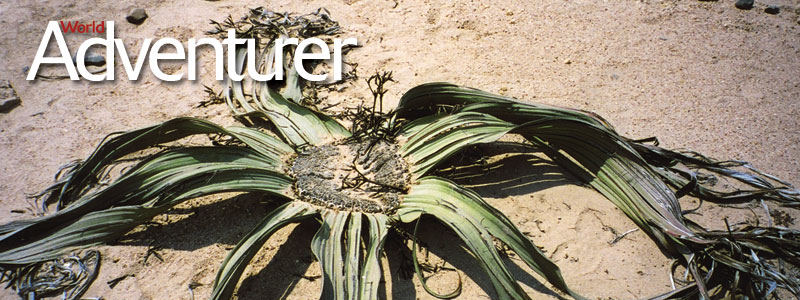Quo Vadis - Namibia
By Dennis Collaton
Unlike more fertile areas, the Namib Desert certainly encourages you to focus your attention. Not seduced by a plethora of colours and greenery as one would be further south in South Africa's lush Cape Province, you concentrate your gaze on the pumice and brown shades of the sandy desert or the bleached wadis of the magnificent sand dunes (among the world's highest), to rest your eye on the odd weathered tree or the ubiquitous and unpalatable euphorbia bushes, tenacious survivors of all the vicissitudes that the wind and scorching sun has to offer them.
You marvel at their fortitude, admire the green relief they bring to the simmering plains, but what really strikes you is their sculptured shape and form brought into stark juxtaposition against the taupe and azure blue background. It is these shapes and forms that stay in your memory like a Fred Williams landscape - only they are in your mind's eye as a broad expanse, not reduced to the confines of a sheet of canvas.
When it comes to tenacity, perhaps the strangest plant of all in this harsh terrain is the Welwitschia. Called by some a living fossil, the Welwitschia Mirabilis (a fitting epithet) is a true survivor and is the only member of the cone-bearing group indigenous to Namibia.
It does however have characteristics of flowering plants. Although considered a tree with a vast root system, it produces during its up to 2,000 year life span, only two true leaves, the longest living in the plant kingdom, growing from its woody stem. The desert winds tear at the fibrous, evergreen leaf blades which sprawl untidily in the desert, shredding them into strips, which subsequently curl into snake-like thongs, leaving the tips withered and dry - it is a rare sight and a truly remarkable phenomenon and survivor!
In fact it was this plant that first drew me to Namibia. One could say, it seems a hell of a long way to go for a plant - and it is. But I have always been drawn to the rare and unlikely of this planet. Viewing this odd child of Mother Nature, shredded, torn and forlorn is akin to looking history in the eye. No wonder on my return, when I close my eyes to recollect my journey, it is the Welwitschia that flashes before me.
For others it may have been the seductive beauty of the marvellous flora of Cape Province, the southernmost tip of the African continent. Yes that surely was beautiful - the wonderful proteas, leucadendrons and the extraordinary diversity of the species-rich fynbos. And let me not forget the jewel-like quality of the Namaqualand spring flower display, which surely would have inspired Monet, should he have been able to visit, to an even greater expression, if that was at all possible, of his art.
For many it was also the geology and the fauna. Can we forget the "other world" Moon Valley landscape or the anticipation of seeing the distinctive, flat-topped Table Mountain looming ahead of us as we travelled south to the "fairest Cape of all".
Perhaps the elephant family carefully mindful of their playful offspring slaking their thirst at the lovely waterhole was the most tender and charming moment.
But for me, I have seen the Welwitschia! Grey green mono-chromatic survivor - this alone of all the wondrous things we saw on our Namibia, Namaqualand and South Africa Tour was the culmination of my journey.

